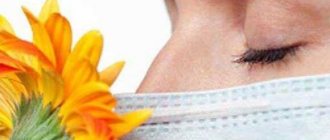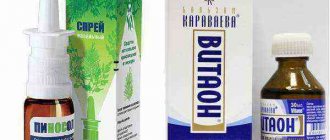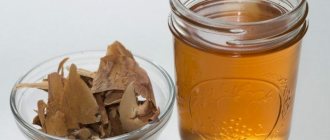Composition, release forms and properties of the drug
The medicine is available in the following forms:
- tablets (50 pieces per package, 0.5 g);
- solution 0.4% for injection in ampoules of 1 and 2 ml;
- eye drops 0.1% in bottles of 5 and 10 ml;
- Dex-gentamicin ointment with dexamethasone and antibiotic.
Ophthalmic drops are used to combat inflammatory and allergic eye diseases. Many otolaryngologists prescribe them for complex lesions of the nose and other ENT organs.
The spectrum of action of the drug is wide:
- anti-inflammatory;
- antiallergic;
- anti-shock;
- anti-exudative (relieves inflammatory or allergic swelling);
- antitoxic;
- immunosuppressive;
- desensitizing (reducing the body's increased sensitivity to foreign objects).
The active component of this hormonal medicine is dexamethasone, an analogue of hydrocortisone and cortisone, which are produced by the adrenal cortex. It is produced synthetically. Interacting with cytoplasmic receptors, it penetrates the cell nucleus and enhances the formation of m-RNA. This, in turn, suppresses the synthesis and activity of a number of substances - mediators of inflammation, allergic reactions and pain.
The composition of nasal drops includes:
- dexamethasone sodium sulfate (1.32 mg per 1 ml of medication, which corresponds to 1 mg of pure dexamethasone);
- boric acid;
- sodium tetraborate;
- benzalkonium chloride;
- trilon B;
- water.
The injection solution contains the same active ingredient, but at a concentration of 4 mg per 1 ml. Its other components are propylene glycol, glycerin, sodium edetate, phosphate buffer solution, propyl and methyl parahydroxybenzoate, water.
Dexamethasone compound drops applied into the nose are effective for complicated diseases.
- Severe forms of sinusitis, complicated by severe nasal congestion and sinusitis;
- Lack of therapeutic effect from treatment with traditional vasoconstrictor nasal agents;
- Allergic manifestations in the form of rhinitis to food or medications;
- Atrophy of the mucous membrane of the nasal passages, which has developed as a result of prolonged use of vasoconstrictor medications.
The use of Dexamethasone in the nose of a child must be prescribed by an ENT doctor, and the solution must be prepared by a pharmacist. Self-preparing drops with Dexamethasone is unacceptable for a child; the drug has side effects and severe symptoms of overdose. A mistake of just 1 ml of substances can lead to unpleasant consequences. An overdose of Dexamethasone can result in an allergic rash, nausea and dizziness, vomiting and headache.
Dexamethasone is a glucocorticoid drug available in solution and tablets. ENT doctors sometimes prescribe this medication in liquid form, which is eye drops, to be dripped into the nose. It is produced in bottles with a transparent yellow or colorless solution.
One bottle contains 5 or 10 ml of medication with a concentration of the active compound of 0.1%. The active substance is dexamethasone sodium phosphate. The solution also contains benzalkonium chloride, disodium edetate, boric acid, sterile water and sodium tetraborate decahydrate.
Contraindications
It has long been known that a runny nose causes various inflammatory and infectious diseases of the respiratory tract. It is especially dangerous when a child suffers from it.
Parents are often concerned that their child’s runny nose does not go away for a long time, and ordinary nasal drops do not give any effect at all. In this case, you should resort to the use of other drugs that are more effective and efficient.
Such drugs are complex nasal drops (later in the article you will be able to see the abbreviation “SK”, which means “complex drops”).
Such drugs are made strictly according to an individual recipe for a specific patient and include several ingredients. Ingredients are selected based on the characteristics of the disease, severity and diagnosis. Also, the concentration and dosage of the drops depends on the concentration of the active substance and the age of the patient.
An otolaryngologist is a specialist who prescribes and composes such drops. Making complex drops on your own is unacceptable, especially if a child will use them.
This is due to the fact that some medications cannot be combined with each other, others are contraindicated for children, others have certain lists of contraindications, etc.
Therefore, only a specialized worker will be able to competently assess the patient’s illness and create an individual prescription for a specific patient.
As a rule, the composition of such drops includes two or more components. It is prepared by pharmacists at any large pharmacy according to prescriptions prepared by otolaryngologists. The patient can also make the composition independently, after consulting with a doctor.
Indications for use:
- when the prescribed treatment does not help, the patient’s condition worsens;
- for severe forms of rhinitis, nasopharyngitis, sinusitis, adenoiditis, otitis, etc.;
- with a mixed nature of diseases, for example, infectious-allergic or viral-bacterial;
- with a long course of the disease and its transition to chronic forms.
As a rule, dexamethasone in the nose is not prescribed for mild, non-severe runny nose.
Complex drops can contain the following components:
- constricting vessels. Used to reduce the severity of mucosal edema; improve aeration of the paranasal sinuses, increase the patency of the nasal passages. Vasoconstrictor - is the main component in the manufacture of complex drops, since it increases the effect of using other ingredients;
- antihistamines. Such components are considered the most important component if the nature of the inflammation of the mucous membrane is an allergic reaction. They are also used to reduce edema due to the fact that they have a vasoconstrictor effect;
- antibacterial type. For bacterial inflammation, antibiotics are used to destroy the pathogen. They are used for purulent discharge, unpleasant and pungent odor of nasal mucus, exacerbation and prolonged course of the disease;
- hormonal. The components of this group have a vasoconstrictor, anti-inflammatory and anti-edematous effect. They are prescribed for allergic genesis and infection.
- Some of the most popular compositions of SC are Naphthyzin (vial), Dioxidine (ampoule), Dexamethasone (ampoule). When swelling of the nasal mucosa is caused only by infectious or inflammatory components, then the composition is used in the form of a mixture of Naphthisin and Dioxidine, and their proportion should be 1:1.
- Aloe juice works great against the anti-inflammatory process.
In this case, Dioxide and Dexamethasone are taken in a ratio of 10:1. After which, a few milliliters of aloe juice are added to the resulting composition. The only drawback is that such complex nasal drops for children have a short shelf life. The duration of their wound should not exceed three days, while other SCs can be stored for up to seven days. - Another frequently used recipe is a mixture of ten milliliters of Dioxidine, one milliliter of Mezaton and several milliliters of Hydrocortisone.
Aloe juice, about one milliliter, can also be added to this mixture, which gives the drops an enhancing anti-inflammatory effect. - Very often, SCs containing ten milliliters of Halozolin and Dioxidine, as well as five milliliters of Dexamethasone, are used.
- If the patient has severe swelling of the mucous membrane and is unable to breathe through the nose, use SK, which includes the following components: one ampoule of Dioxidin, half a bottle of Naphthyzin and one ampoule each of Diphenhydramine and Dexamethasone.
- If a child suffers from a purulent runny nose, doctors prescribe a mixture of five milliliters of Dioxidin and Sulfacyl and one milliliter of Hydrocortisone. To treat children, it is necessary to use a twenty percent solution of Sulfacyl and a 0.5 percent solution of Dioxidin.
- If a child has sinusitis, as well as pronounced swelling of the mucous membrane, then it is necessary to use a mixture of Dexamethasone and Dioxidin, the proportion of which should be 1:5 (in milliliters), it is also recommended to add 10-15 drops of Nazivin.
- The effect of SCs, which contain 5 milliliters of Dioxidin, ten milliliters of Xylene and one ampoule of Dexamethasone, is especially pronounced.
- If the nature of the disease is bacterial, then doctors prescribe complex drops containing antibiotics.
The most commonly used mixture is saline, dexamethasone, and ceftriaxone, the proportion of which is 1:1:1. Similar drops can be used by both adults and children. - Also widely used are complex nasal drops containing one bottle of Cefazolin, two milliliters of hydrocortisone, five of Farmazolin and one of Diphenhydramine.
- Complex drops containing Dioxidin cannot be used if a child or adult suffers from adrenal dysfunction. Also, such drops are contraindicated for pregnant and breastfeeding women.
- If a patient has an allergic reaction to Vibrocil and its components, then such drops should not be used.
It is also not recommended for nursing and pregnant women to take this medicine. - SK based on Diphenhydramine is not recommended for nursing women, young children, as well as patients with bronchial asthma, stomach ulcers, and pregnant women.
- If the patient has bronchial asthma, angle-closure glaucoma, tachycardia or arrhythmia, then Suprastin is not recommended.
- Also, complex nasal drops for children containing Xylene are not used for arterial hypertension, glaucoma, or atherosclerosis.
It should also not be used by pregnant or breastfeeding women. If, nevertheless, it is prescribed, it is recommended to stop breastfeeding. - If the patient has angle-closure glaucoma, severe atherosclerosis or tachycordia, then the use of Farmazolin and Nazivin is not recommended.
- Side effects associated with burning and dry mucous membranes are often common. Typically, such side effects occur when using Dioxidin.
- Rarely, however, side effects associated with nosebleeds occur. Elderly people are at risk of developing glaucoma.
- Rarely occurs when a child feels weakness, nausea, rhythm disturbance, or dizziness.
To reduce the risk of complications from such treatment, it is recommended to use the products for no more than five days. You should also listen to the advice and instructions of your doctor, and do not violate the dosage and instructions for taking the drug. If complex drops are made at home, it is important not to violate the proportions.
The main advantage of SCs is their availability and low price. Also, the complex composition of the drops takes into account the characteristics of the patient for whom they are made.
The main disadvantages of SCs are that safety studies have not been conducted on them. Therefore, if a child uses them, many parents prefer to buy more expensive registered drugs that have undergone clinical trials.
Therefore, it is difficult to say for sure what to choose, complex drops or a ready-made pharmaceutical preparation.
Chronic or acute infectious diseases of the ENT organs, inflammatory reactions due to allergies and other disorders are sometimes difficult to treat with classical drugs, especially in children, so more active agents are used.
Dexamethasone nasal drops or inhalation solution are used as emergency therapy, since the patient’s well-being improves after the first use.
The true purpose of Dexamethasone is the treatment of eye pathologies (keratitis, blepharitis, conjunctivitis, corneal injuries and others), but its active component of a hormonal nature has a pronounced anti-inflammatory, antiallergic, antitoxic and immunomodulatory effect. The drug is prescribed to adults on its own or as part of combined drops; it is used less frequently for children.
Composition and action
Dexamethasone is a potent hormonal drug aimed at treating ophthalmological disorders of an inflammatory, allergic and infectious nature in the acute or chronic phase.
The product contains dexamethasone, a synthetic analogue of corticosteroid hormones that are produced in the adrenal cortex (cortisol, hydrocortisol), as well as a number of other substances: boric acid, benzalkonium chloride, sodium tetraborate, disodium edetate dihydrate.
The drug is available in three main forms: ampoules, tablets and eye drops. Inhalation procedures for the treatment of laryngitis, pharyngitis and other diseases of the ENT organs are carried out with an injection solution, and the latter type of medicine is administered nasally.
It is difficult to briefly describe the effect of hormonal drugs, since they have a complex effect on the body.
The drug also has anti-inflammatory properties; it prevents histamine from interacting with receptors, so inflammation goes away quickly.
The duration of treatment is selected by the doctor; it must be strictly adhered to, since excess hormonal substances can cause side effects. In emergency cases, the medicine is used once, inhalations with the drug for laryngitis in adults or nasal drops for sinusitis are prescribed for a short course (3-7 days).
- conjunctivitis, blepharitis, keratitis, keratoconjunctivitis (non-purulent and allergic forms);
- sympathetic ophthalmia (damage to the choroid of the uninjured eye after penetrating damage to the other eye);
- scleritis, episcleritis;
- damage to the surface layer of the cornea after its complete epithelization;
- uveitis of various etiologies (iridocyclitis, iritis, etc.), i.e. inflammation of the choroid of the eyeball;
- chorioretinitis, choroiditis (inflammation of the posterior part of the eye).
- viral and fungal diseases of the eyes and mucous membranes, for example, herpes keratitis;
- decreased heart rate (tachycardia);
- mild forms of colds, rhinitis and other ENT diseases;
- glaucoma;
- tuberculosis lesions;
- diabetes mellitus;
- arrhythmias;
- impaired corneal integrity;
- high blood pressure;
- the presence of pus, bloody impurities in saliva and sputum;
- mental disorders;
- suppuration of the eyes, nose;
- drug intolerance.
Indications
For oral administration: Addison-Biermer disease; acute and subacute thyroiditis, hypothyroidism, progressive ophthalmopathy associated with thyrotoxicosis; bronchial asthma; rheumatoid arthritis in the acute phase; UC; connective tissue diseases; autoimmune hemolytic anemia, thrombocytopenia, aplasia and hypoplasia of hematopoiesis, agranulocytosis, serum sickness; acute erythroderma, pemphigus (common), acute eczema (at the beginning of treatment); malignant tumors (as palliative therapy); congenital adrenogenital syndrome; cerebral edema (usually after preliminary parenteral use of GCS).
For parenteral administration: shock of various origins; cerebral edema (with a brain tumor, traumatic brain injury, neurosurgical intervention, cerebral hemorrhage, encephalitis, meningitis, radiation injury); status asthmaticus; severe allergic reactions (Quincke's edema, bronchospasm, dermatosis, acute anaphylactic reaction to drugs, serum transfusion, pyrogenic reactions); acute hemolytic anemia, thrombocytopenia, acute lymphoblastic leukemia, agranulocytosis; severe infectious diseases (in combination with antibiotics); acute adrenal insufficiency; acute croup; joint diseases (humeral periarthritis, epicondylitis, styloiditis, bursitis, tendovaginitis, compression neuropathy, osteochondrosis, arthritis of various etiologies, osteoarthritis).
For use in ophthalmological practice: non-purulent and allergic conjunctivitis, keratitis, keratoconjunctivitis without damage to the epithelium, iritis, iridocyclitis, blepharoconjunctivitis, blepharitis, episcleritis, scleritis, inflammatory process after eye injuries and surgical interventions, sympathetic ophthalmia.
Is it possible for children
Composition and action
Despite the availability of Dexamethasone and the high effectiveness of the drug, its use in childhood without a doctor’s prescription is strictly prohibited. This is a powerful drug with serious side effects. Its improper use for treating the nose can cause allergic skin rashes, headaches, nausea and vomiting, and dizziness.
Important: Dexamethasone is contraindicated for children under 18 years of age; it is used at this age only when absolutely necessary, with careful adherence to all specialist instructions.
Components of combined drops
They contain two or more active medicinal components. They are used to quickly cure prolonged rhinitis, sinusitis and other complicated nasal diseases. If complex drops are prescribed, they are prepared by a pharmacist in a pharmacy that has a prescription department. You should not make a nasal solution with Dexamethasone yourself - the dosage and duration of use of the drops is determined by the doctor.
In addition to Dexamethasone, the following components of combined nasal drops are often used:
- antibiotics - Dioxidin, Ceftriaxone;
- antihistamines - Fenistil, etc.;
- vasoconstrictors - Xylene, Naphthyzin;
- saline;
- antiseptics - Miramistin, etc.
Note: in complex nasal drops with Dexamethasone, the combination of the latter with Nazivin and Dioxidin is common. An antimicrobial drug in the presence of a glucocorticosteroid better penetrates the membranes of pathogenic cells and has a more rapid and pronounced bactericidal effect.
The composition of complex nasal drops includes several groups of drugs, hormonal agents and antibacterial, vasoconstrictor and antihistamine. The recipe and dosage are regulated by the attending otorhinolaryngologist.
- Dioxidine. Antibacterial drug, effective against many pathogenic microorganisms. Used in the treatment of purulent runny nose with a bacterial pathogen. Nasal drops containing Dioxidin, Dexamethasone and Naphthyzin are prescribed mainly to adult patients for the treatment of prolonged purulent rhinitis and sinusitis. The bacterial nature of rhinitis must first be confirmed in laboratory tests;
- Dexamethasone. A hormonal synthetic medicine can suppress anti-inflammatory immunity, due to which inflammatory processes in the nasopharynx die out. As a basic therapy, it is prescribed for allergic rhinitis. Dexamethasone with Suprastin is often used, this helps relieve severe swelling of the nasopharynx;
- Fenistil. An antihistamine that has the ability to suppress the sensitivity of histamine receptors and eliminates allergic rhinitis. Often used in the preparation of combination drops with Dexamethasone for children;
- Naphthyzin. Vasoconstrictor. Upon contact with the mucous membrane, the active substance penetrates deep into the skin and connects with the walls of blood vessels, thus narrowing the nasal capillaries and reducing the amount of mucus in the nasal passages. Added to complex nasal drops with Dexamethasone for excessive mucus production and nasal congestion;
- Xylene. Antiallergic medicine. Includes a cell membrane stabilizer that prevents the destruction of granulocytes, which reduces the level of histamine in the blood. The combination of Xylene and Dexamethasone is prescribed for allergic rhinitis with high swelling;
- Ceftriaxone. The third generation antibiotic has a powerful bactericidal effect on the infection. The composition of multicomponent nasal drops with Dexamethasone quickly suppresses inflammation even in acute form.
Dexamethasone: features of the drug
Glucocorticoids are multifunctional, and Dexamethasone is no exception. The medicine is intended to perform the following main functions:
- Anti-inflammatory effect.
- Antitoxic effect.
- Antiallergic effect.
- Anti-shock properties.
- Strengthening the human immune system.
Dexamethasone successfully fights inflammation of the maxillary maxillary sinus
. The drug is available in different forms, but it is most effective when administered intravenously or intramuscularly. The positive effect is achieved 7-8 hours after the injection, and the effect of the medicine lasts from 15 to 28 days. All this allows you to count on a final recovery from the illness that worries you.
Dexamethasone is prescribed for the following diseases and health problems:
- Colds or allergic rhinitis, sinusitis, sinusitis.
- Problems in the functioning of the endocrine system.
- Bronchitis and bronchial asthma.
- Inflammatory processes in the joints.
- Brain damage, leukemia.
Dexamethasone is prescribed for various types of sinusitis.
Depending on the severity of the disease, the use of the drug in one form or another is prescribed. Today in pharmacies you can find Dexamethasone in drops, as well as in the form of a solution for intravenous and intramuscular injections. Drops are used to eliminate the symptoms of the early stages of sinusitis, injections are given if treatment of the disease does not produce positive results, and the disease itself continues to actively progress.
However, permission to use Dexamethasone must be given exclusively by the attending physician. Initially, the specialist conducts an examination, based on the results of which one or another course of treatment is prescribed.
Before using the product, it is important to consult with your doctor
Dexamethasone treatment: dexamethasone inhalation or nasal drops
Despite the fact that the instructions for Dexamethasone do not contain information about the use of the drug for inhalation, doctors use them in their practice. The method is effective in the treatment of catarrhal laryngitis for dilatation of the bronchi, for allergic reactions of the respiratory system, for relieving the symptoms of prolonged pharyngitis, for acute inflammation of the respiratory system (bronchitis, laryngitis).
To prepare the composition for the inhaler, prepare a bottle of saline solution, 1 ampoule of Dexamethasone 0.4%. The latter is used for inhalation by diluting it with physiological solution (pharmaceutical sodium chloride solution) six times. That is, if 0.5 ml is taken for children and 1 ml of Dexamethasone for adults, then the saline solution should be 3 and 6 ml, respectively.
Such inhalations are given to a child in extreme cases, for example, when it is necessary to quickly relieve swelling of the larynx and restore breathing during anaphylactic shock. For sore throat and other inflammatory pathologies of the ENT organs, the procedure is used strictly as prescribed by a specialist for children over three years of age, just like Dexamethasone nasal drops.
There is nothing worse when children get sick. I want to help them at any cost, alleviate their suffering and find a medicine that will help the child get back on his feet. Dexamethasone is one such drug.
A drug such as Dexamethasone helps make life easier for children. This medicine allows you to immediately provide help to a child, especially when he does not have enough air and begins to choke.
This drug is a hormonal drug and is excellent in solving problems associated with respiratory diseases in children.
When a child has problems with the respiratory system, Dexamethasone can be taken, and not only in the form of injections. A single dose of this drug helps not only completely get rid of acute laryngitis, but also prevents its recurrence.
When anaphylactic shock occurs in children, Dexamethasone is one of the main helpers, as it helps to raise blood pressure and normalize it, which is necessary for the normal functioning of the cardiovascular system. Anaphylactic shock can cause premature death, Dexamethasone helps prevent such consequences.
There are various dosage forms of Dexamethasone, such as:
- Tablet form;
- In ampoules;
- Solution in drops.
To treat a child using inhalation, an injection solution is used. Available in ampoules of 1 ml. One ampoule contains 4 mg of the main substance.
The drug Dexamethasone is a glycocorticosteroid, as it is made from hormones of the adrenal cortex, influencing various metabolisms in the body, such as carbohydrate and protein. That is why this medicine is considered the most complex and potent. That is why it cannot always be used.
Before using this drug, you should pay attention to the following contraindications:
- There is increased sensitivity or intolerance to certain components of the drug;
- sputum containing pus is produced;
- if your body temperature has risen;
- the protective functions of the child’s body are reduced;
- there are problems in the functioning of the cardiovascular system;
- Various mental illnesses are diagnosed in children.
Inhalations using Dexamethasone are very popular among many doctors. They prescribe them for the treatment of diseases associated with the respiratory system. Such inhalations have a local effect on the child’s body.
When a glucocorticosteroid is sprayed on the bronchial walls, small particles settle.
Thanks to this therapy, the use of the drug completely eliminates any harmful effects on the body, and dry and allergic coughs disappear, since inhalations are the best way to solve this problem.
In this case, self-medication should be completely excluded and the drug should be prescribed under the strict supervision of a doctor.
This is fraught with the fact that when hypersensitivity to some components of the drug is detected, the child immediately develops anaphylactic shock or Quincke's edema.
Inhalations have found wide application in medicine. They help especially well in the field of diseases of the respiratory system. As a rule, inhalations are prescribed in the following cases:
- if you have laryngitis or pharyngitis;
- when identifying respiratory viral pathologies of infectious origin;
- in the treatment of pneumonia, but only when recovery is underway;
- with the development of bronchitis in a child of any type, except purulent;
- with the progression of tuberculosis;
- with the appearance and progression of fungal infections in the respiratory tract.
Cure diseases of the respiratory system using inhalations much more effectively and quickly. But the treatment must be carried out correctly. So how to do inhalations with Dexamethasone correctly so that they bring benefits and not even more harm?
A nebulizer inhaler is best suited for such procedures, since it is with it that the treatment will be most effective. For inhalations, in addition to Dexamethasone, saline solution will be needed, because undiluted Dexamethasone can cause shock in the child.
In no case should a child be inhaled with this drug without a doctor’s prescription, since in childhood the risk to the body when using hormonal drugs is very high.
For a child, the following dosage is used during inhalation: 0.5 ml of the drug and 3 ml of saline solution. Inhalations are carried out twice a day.
It is important to remember that under no circumstances should you inhale with undiluted Dexamethasone.
For children, the inhalation time should not be very long and preferably before bedtime, so that bronchospasms do not develop at night.
When a child develops sniffles or some other problems associated with the nose, doctors recommend using nasal drops in such cases.
These drops are prescribed when treatment has been delayed and other nasal medications have not helped. Nasal drops should only be prescribed by specialists. In addition, you must also read the instructions.
Nowadays, complex drops are not so often prescribed, since combined ones have simply replaced them.
Such nasal drops are widely used in the treatment of various pathologies of the respiratory system and allergies in children. Dexamethasone has a decongestant, anti-inflammatory and antiallergic effect on the body.
These drops should not be used by pregnant and lactating women, as well as children under 12 years of age.
Nasal drops help effectively and quickly cure an allergic reaction. It is necessary to instill the medicine into the nose three times a day for seven days.
That is why, when prescribed to children over 12 years of age, it should be used with caution and only after consultation with specialists.
You can easily find any information and reviews on the Internet. So, reviews of Dexamethasone nasal drops can be easily found on many review sites. This drug is praised by many, mentioning that treatment with these nasal drops gives a quick and positive effect. Medical specialists also recommend this unique drug with great confidence.
Composition and action
DEXAMETHASONE: SIDE EFFECTS
From the endocrine system: decreased glucose tolerance, steroid diabetes mellitus or manifestation of latent diabetes mellitus, suppression of adrenal function, Itsenko-Cushing syndrome (including moon face, pituitary type obesity, hirsutism, increased blood pressure, dysmenorrhea, amenorrhea, myasthenia gravis , striae), delayed sexual development in children.
Metabolism: increased excretion of calcium ions, hypocalcemia, increased body weight, negative nitrogen balance (increased protein breakdown), increased sweating, hypernatremia, hypokalemia.
From the central nervous system: delirium, disorientation, euphoria, hallucinations, manic-depressive psychosis, depression, paranoia, increased intracranial pressure, nervousness or anxiety, insomnia, dizziness, vertigo, pseudotumor of the cerebellum, headache, convulsions.
From the cardiovascular system: arrhythmias, bradycardia (up to cardiac arrest); development (in predisposed patients) or increased severity of chronic heart failure, ECG changes characteristic of hypokalemia, increased blood pressure, hypercoagulation, thrombosis. In patients with acute and subacute myocardial infarction - the spread of necrosis, slowing down the formation of scar tissue, which can lead to rupture of the heart muscle; with intracranial administration - nosebleeds.
From the digestive system: nausea, vomiting, pancreatitis, steroid ulcer of the stomach and duodenum, erosive esophagitis, bleeding and perforation of the gastrointestinal tract, increased or decreased appetite, flatulence, hiccups; rarely - increased activity of liver transaminases and alkaline phosphatase.
From the senses: posterior subcapsular cataract, increased intraocular pressure with possible damage to the optic nerve, a tendency to develop secondary bacterial, fungal or viral eye infections, trophic changes in the cornea, exophthalmos.
From the musculoskeletal system: slower growth and ossification processes in children (premature closure of the epiphyseal growth plates), osteoporosis (very rarely - pathological bone fractures, aseptic necrosis of the head of the humerus and femur), rupture of muscle tendons, steroid myopathy, decreased muscle mass (atrophy).
Dermatological reactions: delayed wound healing, petechiae, ecchymosis, skin thinning, hyper- or hypopigmentation, steroid acne, stretch marks, tendency to develop pyoderma and candidiasis.
Allergic reactions: generalized (including skin rash, skin itching, anaphylactic shock) and when applied topically.
Effects associated with immunosuppressive effects: development or exacerbation of infections (the appearance of this side effect is facilitated by jointly used immunosuppressants and vaccination).
Local reactions: with parenteral administration - tissue necrosis.
For external use: rarely - itching, hyperemia, burning, dryness, folliculitis, acne, hypopigmentation, perioral dermatitis, allergic dermatitis, skin maceration, secondary infection, skin atrophy, stretch marks, prickly heat. With long-term use or application to large areas of skin, systemic side effects characteristic of GCS may develop.
Reviews
There are quite a lot of positive reviews about the treatment with Dexamethasone. The medication is praised for its effective and rapid action, noting that it helps well with allergic diseases. If such drops are prescribed by a doctor and the dosage is not exceeded, then no side effects from such treatment are often detected.
For this reason, they prefer medications from the same group of glucocorticoids, but intended specifically for administration into the nasal passages. The concentration of the active substance in such drugs is lower, which makes them safer, but does not reduce the therapeutic effect.
Analogs
Other hormonal local remedies can replace nasal drops with dexamethasone - for example, Nasonex, Nazarel, Desrinit, Flixonase or Avamys. They are produced in the form of a nasal spray and are used for allergic rhinitis, acute sinusitis, and chronic inflammation of the paranasal sinuses. Since their effect is ensured by different substances and each of them has its own characteristics of use, a doctor must select an analogue.
In the next video, Dr. Komarovsky will tell you what vasoconstrictor drops are, how to use them correctly, and how do adult drops differ from children’s drops?
- Dexamethasone instructions for use price, reviews, analogues and when to prescribe
- Buy Clotrimazole drops for nails at prices starting from 297 rubles, order Clotrimazole drops for nails inexpensively in an online pharmacy in Moscow
- Cetrin - instructions for use, indications, analogues, reviews
- Cromohexal eye drops instructions for use
Treatment of sinusitis
The inflammatory process that occurs during sinusitis affects both the nasal passages and the maxillary sinuses. All this does not go unnoticed by a person, because then he is faced with the following symptoms:
- Copious nasal discharge.
- Accumulation of pus in the paranasal sinuses.
- Headache, especially with slight pressure on the affected area.
- Toothache.
- Nasal congestion and difficulty breathing.
Nasal congestion is one of the most common symptoms of sinusitis.
Treatment should begin after visiting an otolaryngologist. In each individual case, the specialist prescribes an individual course of treatment, which will consist of the use of antibiotics, nasal drops, sprays, physiotherapy and other therapeutic methods.
If the inflammatory process cannot be stopped, and mucus continues to accumulate in the sinuses, which then turns into pus, doctors prescribe special injections. Dexamethasone injections are often prescribed for sinusitis, which should stop inflammation and prevent serious complications of the disease.
In a situation where conservative treatment does not help, the patient is referred to undergo a mini-operation to remove purulent masses by puncturing the maxillary sinus. To avoid this, treatment of the disease should begin at the earliest stage of its development.
If you delay treatment of sinusitis, you will have to agree to a puncture of the maxillary sinus










